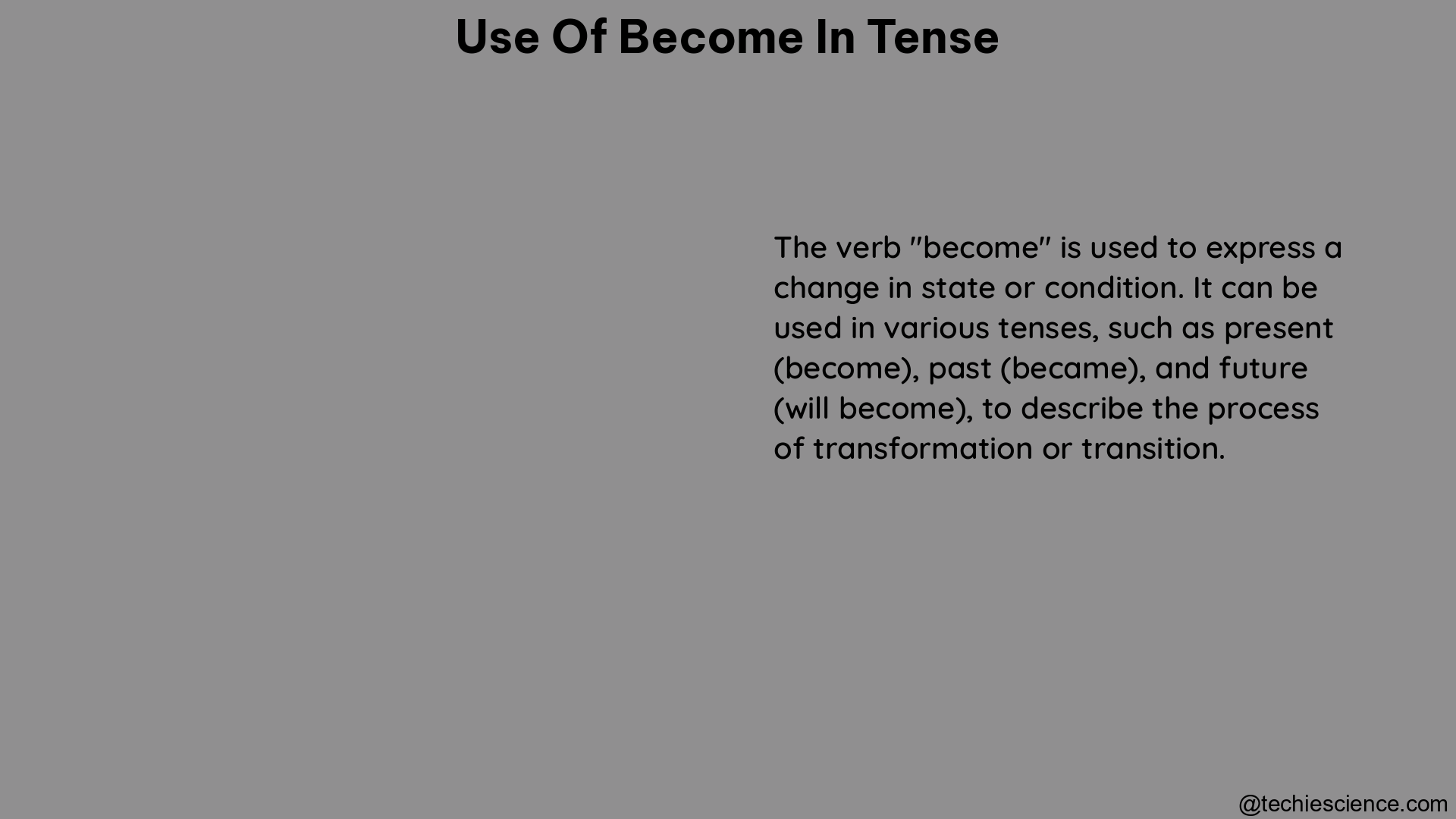The verb “become” is an essential part of the English language, but its usage in different tenses can be complex and challenging for language learners. This comprehensive guide will provide you with a detailed understanding of how to use “become” in various tenses, including examples and important notes to help you master this irregular verb.
Present Tense
In the present tense, the verb “become” follows the standard subject-verb agreement rules:
- Singular: I become, you become, he/she/it becomes
- Plural: we become, you become, they become
Examples:
– “I become more confident each day.”
– “She becomes the CEO of the company.”
– “They become friends after working together.”
Present Progressive Tense

The present progressive tense is used to describe an ongoing action or a process that is currently happening. The structure is: subject + “be” verb + “becoming”:
- Singular: I am becoming, you are becoming, he/she/it is becoming
- Plural: we are becoming, you are becoming, they are becoming
Examples:
– “I am becoming more interested in learning a new language.”
– “She is becoming a skilled painter.”
– “They are becoming more environmentally conscious.”
Past Tense
The past tense of “become” is “became,” which is an irregular verb form. The structure is: subject + “became”:
- Singular: I became, you became, he/she/it became
- Plural: we became, you became, they became
Examples:
– “I became a teacher after completing my education.”
– “She became a successful entrepreneur.”
– “They became close friends over the years.”
Present Perfect Tense
The present perfect tense is used to describe an action that has been completed in the past but has relevance to the present. The structure is: subject + “have/has” + “become”:
- Singular: I have become, you have become, he/she/it has become
- Plural: we have become, you have become, they have become
Examples:
– “I have become more confident in my abilities.”
– “She has become a renowned artist.”
– “They have become leaders in their field.”
Present Perfect Progressive Tense
The present perfect progressive tense is used to describe an ongoing action or process that began in the past and is still continuing. The structure is: subject + “have/has” + “been” + “becoming”:
- Singular: I have been becoming, you have been becoming, he/she/it has been becoming
- Plural: we have been becoming, you have been becoming, they have been becoming
Examples:
– “I have been becoming more interested in sustainable living.”
– “She has been becoming a more skilled writer over the years.”
– “They have been becoming more environmentally conscious.”
Past Progressive Tense
The past progressive tense is used to describe an ongoing action or process that was happening in the past. The structure is: subject + “was/were” + “becoming”:
- Singular: I was becoming, you were becoming, he/she/it was becoming
- Plural: we were becoming, you were becoming, they were becoming
Examples:
– “I was becoming more confident in my public speaking skills.”
– “She was becoming a more experienced leader.”
– “They were becoming more interested in learning a new language.”
Past Perfect Tense
The past perfect tense is used to describe an action that was completed before another past action or a specific point in time. The structure is: subject + “had” + “become”:
- Singular: I had become, you had become, he/she/it had become
- Plural: we had become, you had become, they had become
Examples:
– “I had become a skilled programmer before applying for the job.”
– “She had become a successful entrepreneur by the time she was 30.”
– “They had become close friends before moving to a different city.”
Past Perfect Progressive Tense
The past perfect progressive tense is used to describe an ongoing action or process that was happening before another past action or a specific point in time. The structure is: subject + “had” + “been” + “becoming”:
- Singular: I had been becoming, you had been becoming, he/she/it had been becoming
- Plural: we had been becoming, you had been becoming, they had been becoming
Examples:
– “I had been becoming more interested in sustainable living before the pandemic.”
– “She had been becoming a more skilled writer for several years before her first book was published.”
– “They had been becoming more environmentally conscious before the new regulations were implemented.”
Future Tense
The future tense is used to describe an action that will happen in the future. The structure is: subject + “will” + “become”:
- Singular: I will become, you will become, he/she/it will become
- Plural: we will become, you will become, they will become
Examples:
– “I will become a doctor after completing my medical studies.”
– “She will become the CEO of the company in the next few years.”
– “They will become close friends over time.”
Future Progressive Tense
The future progressive tense is used to describe an ongoing action or process that will be happening in the future. The structure is: subject + “will” + “be” + “becoming”:
- Singular: I will be becoming, you will be becoming, he/she/it will be becoming
- Plural: we will be becoming, you will be becoming, they will be becoming
Examples:
– “I will be becoming more fluent in Spanish as I continue to practice.”
– “She will be becoming a more experienced leader as she takes on more responsibilities.”
– “They will be becoming more environmentally conscious as they learn about sustainable practices.”
Future Perfect Tense
The future perfect tense is used to describe an action that will be completed before another future action or a specific point in time. The structure is: subject + “will” + “have” + “become”:
- Singular: I will have become, you will have become, he/she/it will have become
- Plural: we will have become, you will have become, they will have become
Examples:
– “I will have become a skilled programmer by the time I graduate.”
– “She will have become a renowned artist by the time she retires.”
– “They will have become close friends by the time they move to a different city.”
Future Perfect Progressive Tense
The future perfect progressive tense is used to describe an ongoing action or process that will be happening before another future action or a specific point in time. The structure is: subject + “will” + “have” + “been” + “becoming”:
- Singular: I will have been becoming, you will have been becoming, he/she/it will have been becoming
- Plural: we will have been becoming, you will have been becoming, they will have been becoming
Examples:
– “I will have been becoming more fluent in Spanish by the time I travel to Spain.”
– “She will have been becoming a more skilled writer for several years before her first book is published.”
– “They will have been becoming more environmentally conscious before the new regulations are implemented.”
Important Notes
- “Become” is an irregular verb, and its past tense is “became” while its past participle is “become”.
- The present perfect tense is formed using “has” or “have” with the past participle “become”.
- The usage of “become” in different tenses can be complex, but understanding the structures and examples provided in this guide can help you master this verb.
References
- https://www.thoughtco.com/example-sentences-with-the-verb-become-1211154
- https://homework.study.com/explanation/what-is-the-present-tense-of-become.html
- https://www.writingenglish.com/cverbs/become.htm
- https://www.wordreference.com/conj/enverbs.aspx?v=become
- https://ell.stackexchange.com/questions/115455/what-tense-is-has-became

Hi…. I am Goutam Datta. I have completed a double M. A. in English and B. Ed. I am a creative writer. Currently, I am a part of the LambdaGeeks.